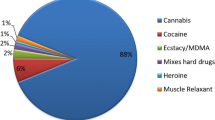Abstract
This paper examines the relationship of frequency, type of alcohol use, sexual risk behaviors and sexually transmitted infections (STIs) among married men living in economically marginal communities in Mumbai, India. The findings indicate that men who consume alcohol daily were four times more likely to have had extramarital sex in the past 12 months. In terms of sexually transmitted infections, men who were daily drinkers were four times more likely than those not consuming alcohol in the last month to have gonorrhea (NG) and Chlamydia (CT) infection and three times more likely to have had a past history of exposure to herpes simplex virus-2 (HSV-2) and/or syphilis as determined by biological testing. These results demonstrate that men with daily alcohol use are at greatest risk for STIs and need to be targeted for community outreach, de-addiction services and sex risk reduction education program in India and elsewhere.
Similar content being viewed by others
References
Patel SK, Niranjan S. Linkages between substance use, couple characteristics and reproductive behavior in India. In: Tripathy SN, Bishoyi D, Patel SK, editors. Dynamics of population issues. New Delhi: Sonali Publications; 2007.
Basu K. Globalization and culture. India Today; 20 April 1998.
Benegal V. India: alcohol and public health. Addiction. 2005;100(8):1051–6.
Ustun TB. The world health surveys. In: Murray CJL, Evans DB, editors. Health systems performance assessment: debates, methods and empiricism. Geneva: World Health Organization; 2003.
MacDonald TK, Zanna MP, Fong GT. Why common sense goes out the window: effects of alcohol on intentions to use condoms. Pers Soc Psychol Bull. 1996;22:763–75.
Weinhardt LS, Carey MP. Does alcohol lead to sexual risk behaviour? Findings from event-level research. Annu Rev Sex Res. 2000;11:125–57.
Kalichman SC, Weinhardt L, DiFonzo K, Austin J, Luke W. Sensation seeking and alcohol use as markers of sexual transmission risk behaviours in HIV-positive men. Ann Behav Med. 2002;24:229–35.
Testa M. The impact of men’s alcohol consumption on perpetration of sexual aggression. Clin Psychol Rev. 2002;22:1239–63.
NACO. National baseline high risk and bridge population behavioural surveillance survey 2002. New Delhi: National AIDS Control Organization; 2002.
Sivaram S, Latkin CA, Solomon S, Celentano DD. HIV prevention in India: focus on men, alcohol use and social networks. Harv Health Policy Rev. 2006;7(2):125–34.
Chaturvedi S, Singh Z, Banerjee A, Khera A, Joshi RK, Dhrubajyoti D. Sexual behaviour among long distance truck drivers. Indian J Commun Med. 2006;31(3):153–6.
Go V, Sethulakshmi C, et al. When HIV-prevention messages and gender norms clash: the impact of domestic violence on women’s HIV risk in slums of Chennai, India. AIDS Behav. 2003;7(3):263–72.
Halphen-Felsher BL, Millstein SG, Ellen JM. Relationship of alcohol use and risky sexual behavior: a review and analysis of findings. J Adolesc Health. 1996;19:331–6.
Zuckerman M, Eysenck S, Eysenck HJ. Sensation seeking in England and America: cross-cultural, age and sex comparisons. J Consult Clin Psychol. 1978;46:139–49.
Zuckerman M. Behavioural expressions and biosocial bases of sensation seeking. New York: Cambridge University Press; 1994.
Chandra PS, Krishna VAS, Benegal V, Ramakrishna J. High-risk sexual behaviour and sensation seeking among heavy alcohol users. Indian J Med Res. 2003.
Das S, Yemul V, Deshmukh R. Incidence and association of HIV and other STDs in 200 persons belonging to a high risk group in central Mumbai. Venereology. 1998;11(1):19–23.
Madhivanan P, Hernandez A, et al. Alcohol use by men is a risk factor for the acquisition of sexually transmitted infections and human immunodeficiency virus from female sex workers in Mumbai, India. Sex Transm Dis. 2005;32(11):685–90.
Schensul SL, Verma RK, Nastasi BK. Responding to men’s sexual concerns: research and intervention in slum communities in Mumbai, India. Int J Men’s Health. 2004;3:197–220.
Schensul SL, Mekki-Berrada A, Nastasi BK, Saggurti N, Verma RK. Healing traditions and men’s sexual health in Mumbai, India: the realities of practiced medicine in urban poor communities. Soc Sci Med. 2006;62:2774–85.
Saggurti N, Schensul SL, Verma RK. Migration, mobility and sexual risk behaviour in Mumbai, India: mobile men with non-residential wife show increased risk. AIDS Behav. 2009;13(5):921–7.
Schensul SL, Hawkes S, Saggurti N, Verma RK, Narvekar SS, Nastasi BK, Burleson JA, Risbud A. STIs in men in Mumbai slum communities: the relationship of prevalence to risk behavior. Sex Transm Dis. 2007;34(7):444–50.
WHO. Guidelines for the management of sexually transmitted infections. Geneva, Switzerland: World Health Organization; 2003.
Go VF, Solomon S, Srikrishnan AK, Sivaram S, Johnson SC, Sripaipan T, Murugavel KG, Latkin C, Mayer K, Celentano DD. HIV rates and risk behaviors are low in the general population of men in Southern India but high in alcohol venues: results from 2 probability samples. J Acq Immune Def Syndr. 2007;46(4):491–7.
International Institute for Population Sciences (IIPS) and Macro International. National family health survey (NFHS-3), 2005–2006. Vol I. Mumbai, India: IIPS; 2007. http://www.measuredhs.com/pubs/pdf/FRIND3. Accessed 3 July 2009.
Acknowledgements
This study was supported by the National Institute of Mental Health grant R01-MH064875. The authors would like to thank the organizers of the Alcohol and Sexual Risk Conference, Dr. Jean J. Schensul, Senior Researcher and Founding Director of the Institute for Community Research in Hartford, CT, USA and Dr. S.K. Singh, Associate Professor, International Institute for Population Sciences, Mumbai, India, where this paper was first presented. Source of Support: Analyses for this study were conducted via funding from the National Institute of Mental Health (Grant #: R01-MH064875).
Author information
Authors and Affiliations
Corresponding author
Rights and permissions
About this article
Cite this article
Saggurti, N., Schensul, S.L. & Singh, R. Alcohol Use, Sexual Risk Behavior and STIs Among Married Men in Mumbai, India. AIDS Behav 14 (Suppl 1), 40–47 (2010). https://doi.org/10.1007/s10461-010-9728-6
Published:
Issue Date:
DOI: https://doi.org/10.1007/s10461-010-9728-6



